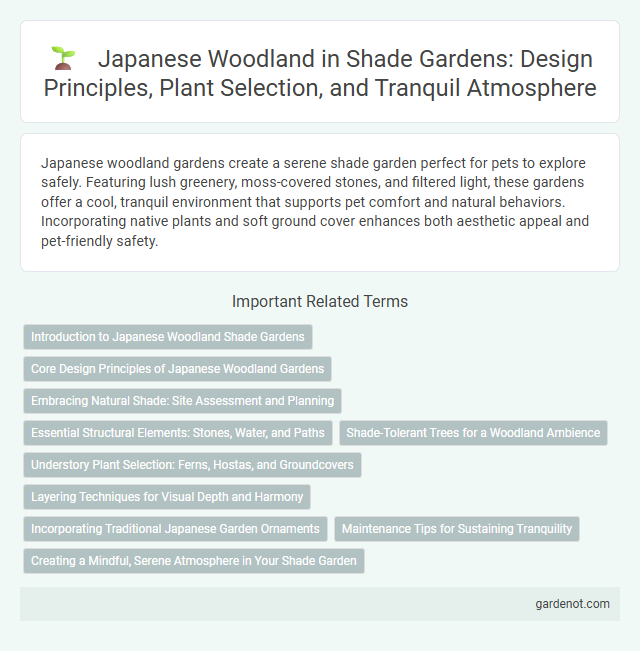Japanese woodland gardens create a serene shade garden perfect for pets to explore safely. Featuring lush greenery, moss-covered stones, and filtered light, these gardens offer a cool, tranquil environment that supports pet comfort and natural behaviors. Incorporating native plants and soft ground cover enhances both aesthetic appeal and pet-friendly safety.
Introduction to Japanese Woodland Shade Gardens
Japanese woodland shade gardens embody tranquility through carefully curated native plants such as ferns, mosses, and hostas that thrive in low light conditions. These gardens emphasize natural textures, muted colors, and asymmetrical layouts to mimic the serene understory of a Japanese forest. Incorporating elements like stone lanterns, water features, and winding paths enhances the immersive, contemplative atmosphere characteristic of traditional Japanese garden design.
Core Design Principles of Japanese Woodland Gardens
Japanese woodland gardens emphasize natural harmony, using native plants like moss, ferns, and maples to create layered textures that thrive in shaded environments. The core design principles include asymmetry, simplicity, and minimalism, which encourage tranquility and evoke a sense of timelessness. Strategic placement of stones, pathways, and water features guides contemplation and enhances the garden's serene atmosphere.
Embracing Natural Shade: Site Assessment and Planning
Site assessment for a Japanese woodland shade garden involves analyzing light patterns, soil moisture, and existing vegetation to ensure optimal plant placement. Embracing natural shade requires selecting shade-tolerant species like hostas, ferns, and Japanese maples that thrive in low-light conditions. Thoughtful planning respects the garden's natural contours and microclimates, promoting biodiversity and a serene atmosphere.
Essential Structural Elements: Stones, Water, and Paths
Japanese woodland shade gardens emphasize essential structural elements such as carefully placed stones that provide natural texture and visual balance. Flowing water features enhance tranquility and create soothing soundscapes, reflecting traditional Zen influences. Meandering paths guide visitors through the shaded spaces, fostering contemplative walking experiences while connecting key garden components seamlessly.
Shade-Tolerant Trees for a Woodland Ambience
Japanese woodland gardens thrive with shade-tolerant trees such as Acer palmatum (Japanese maple), Fagus sylvatica (European beech), and Tsuga canadensis (Canadian hemlock), which create a layered canopy enhancing the tranquil ambiance. These species adapt well to low light conditions, encouraging lush undergrowth and promoting biodiversity within shaded garden areas. Incorporating shade-loving evergreens and deciduous trees establishes year-round texture, color, and structure essential for authentic woodland aesthetics.
Understory Plant Selection: Ferns, Hostas, and Groundcovers
Japanese woodland shade gardens thrive with a carefully curated understory featuring ferns, hostas, and groundcovers like ajuga and pachysandra. Ferns such as Athyrium niponicum provide delicate fronds that complement the textured leaves of hostas, which vary from deep green to variegated patterns, enhancing the garden's visual depth. Low-growing groundcovers, including creeping jenny and sweet woodruff, form lush carpets that suppress weeds and retain soil moisture, ensuring a balanced and thriving woodland ecosystem.
Layering Techniques for Visual Depth and Harmony
Japanese woodland gardens employ layering techniques that enhance visual depth and harmony by arranging plants in staggered heights and textures, simulating natural forest environments. Ground covers like mosses and ferns create a lush base layer, while medium-height shrubs such as azaleas provide mid-level interest, and taller trees like maples offer canopy structure. This strategic layering fosters a serene atmosphere that reflects the balance and tranquility central to traditional Japanese garden design.
Incorporating Traditional Japanese Garden Ornaments
Incorporating traditional Japanese garden ornaments such as stone lanterns, bamboo water fountains (shishi-odoshi), and moss-covered statues enhances the serene atmosphere of a Japanese woodland shade garden. These elements harmonize with native plants like ferns, azaleas, and maples, creating a balanced, tranquil space that reflects centuries-old garden design principles. Utilizing authentic materials like weathered granite and natural bamboo ensures the garden remains true to traditional aesthetics while promoting quiet contemplation.
Maintenance Tips for Sustaining Tranquility
Japanese woodland shade gardens thrive with regular pruning to maintain the natural flow and prevent overgrowth. Applying a layer of organic mulch conserves moisture and suppresses weeds, promoting healthy root systems for maples and ferns. Consistent monitoring for pests and fungal diseases ensures a peaceful, balanced environment that supports the garden's tranquil aesthetic.
Creating a Mindful, Serene Atmosphere in Your Shade Garden
Japanese woodland gardens emphasize tranquility through layered plantings of ferns, mosses, and shade-tolerant shrubs like azaleas and Japanese maples, cultivating a peaceful retreat. Incorporating natural elements such as smooth stones, water features, and subtle pathways enhances mindfulness and serenity in shaded spaces. The soft dappled light filtered through tree canopies fosters a meditative environment essential for reflecting the essence of traditional Japanese garden aesthetics.
Japanese woodland Infographic

 gardenot.com
gardenot.com